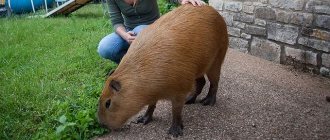2.8
(6)
The common hamster is distinguished by its ability to survive in any conditions; they are not afraid of harsh winters and hot, arid climates. They are distinguished by aggressive behavior and pose a danger not only to crops, but also to people and domestic animals. Wild hamsters always and everywhere fiercely guard their territory and can attack without warning any “unwanted guest.” In this article we will tell you how to get rid of hamsters in your dacha and what methods to use to combat these pests.
The common hamster is omnivorous, but its main food is fruits, root vegetables and grains. In conditions of shortage of plant food, the diet of hamsters includes earthworms, insects and even frogs. Moreover, there is evidence that hamsters eat chicks, as well as small rodents.
The saliva of the common hamster contains more than 30 types of infections.
If bitten, there is a high risk of blood poisoning. Therefore, when catching hamsters, one should not forget about precautions. You can distinguish a hamster from other large rodents by the color of its coat, which is characterized as tricolor. The upper part of the rodent's body is covered with reddish-brown hair, the lower part is covered with black or dark brown hair.
Hamsters have characteristic large cheek pouches that fill to capacity with food. They tend to tirelessly stock up on food for the winter; they store supplies in a hole in the pantry. The capacity of the pantry is amazing - up to 90 kg.
The appearance of hamsters in the country: causes and signs
The body length of the common hamster reaches up to 40 cm, weight approximately 500 - 600 g.
Hamsters are not afraid of human society; they often choose a place to live in gardens and vegetable plots. They can also live in residential premises, but on the condition that there is enough food inside and outside the premises. Let's consider the main signs indicating the presence of hamsters on a personal plot:
- minks;
- footprints;
- travel routes;
- eaten or bitten vegetables and fruits;
- small tunnels leading to plant tubers;
- eaten bark on the bottom of trees and shrubs.
Why are rodents dangerous?
A wild hamster is not as harmless an animal as it might seem at first glance. It can bring the following troubles:
- Significantly reduce the yield of vegetables and spoil the quality of tubers and green vegetables.
- During the construction of a burrow, a rodent can damage the root system of fruit trees and berry bushes.
- Animals can get into the house. After they leave, bitten vegetables, droppings and chewed furniture will remain.
- In case of sudden danger, the animal is capable of attacking a person or pet (although this does not happen often).
- They spread pathogenic infections.
At the first signs of the appearance of rodents, it is necessary to urgently take measures to remove them from the country estate.
The main reasons for dealing with hamsters at the first sign of their appearance
The burrow of a common hamster reaches up to 10 m, the depth of the burrow is up to 2 m. The burrow is divided into a true nest, a pantry and a latrine, and has up to 5 false entrances and exits.
Fighting hamsters should begin at the first sign of their appearance, due to the following reasons:
- Hamsters are constantly in search of food, thereby causing irreparable damage to plants, trees and shrubs.
- It is known that hamsters lead a solitary lifestyle, but when they find a nourishing area, they share this information with their relatives.
- Due to the high fertility of hamsters, in one season hamsters are able to populate more than one hectare. From April to October, a female brings up to a hundred cubs, since pregnancy lasts no more than 16 days, and the number of cubs born is from 5 to 20. After only 2 months, females from the first litter are considered sexually mature and capable of having their own children.
- Grown-up baby hamsters constantly feel the need to chew something, this is mainly due to sharpening their teeth. In the first few weeks, the young come out of the hole and begin to gnaw on everything that comes their way.
- Hamsters quickly transmit information related to threat and danger. Hamsters begin to avoid dangerous areas, ignore baits and even create false paths leading to an abandoned hole. Thus, a huge number of effective control methods become useless.
Ultrasonic repellers
Recently, various devices for controlling rodents in the country have become increasingly popular. Ultrasonic repellers are widely used for these purposes, which emit sounds that are intolerable to the pest but inaudible to humans.
The following advantages of this method can be highlighted:
- there are no corpses left on the site, the animals simply run away;
- there is no chance of poisoning;
- ultrasound will help drive out not only karbysh, but also field mice, moles and rats;
- you can turn on the device only at night, because your enemies lead a twilight lifestyle and rarely make forays during the day;
- The method of combating is absolutely not labor-intensive, you just need to insert batteries and install the devices in your summer cottage.
However, the ultrasonic method is not the most reliable due to obvious disadvantages:
- Karbysh do not die, but simply leave your site. Your neighbors won't thank you for such an expulsion.
- When the batteries in the device run out, the animals will return again (not relevant for ultrasonic devices operating on mains power).
- The device is quite expensive, plus high costs for batteries or electricity consumption.
- Pets can also perceive ultrasound, but it is harmful to them.
There is also an opinion in scientific circles that ultrasound is harmful to humans, although their hearing is not susceptible to high-frequency sound waves. Ultrasound radiation can destroy the membrane structures of cells, causing various diseases. That is, this method is best used when there are neither pets nor the owners themselves at the country estate.
There are ultrasonic repellers that operate on batteries, but they are not easy to find in stores. Much more common are devices that connect to the mains. Below are the models that are most in demand in the fight against wild hamsters.
- "Tornado". Powered by mains, coverage area – 4 acres. Costs from 2100 rubles. A more powerful device with a coverage of 8 acres can be purchased for 3,200 rubles.
- "Typhoon 800". Also works from a wall outlet. Effective on a garden plot with an area of 8 acres. Cost – from 1400 rubles.
- "Grad 500". Powered by AA batteries, coverage area up to 5 acres. Minimum price 1700 rubles.
- "Chiston 4". The device is designed for 5 acres, powered from an outlet. Cost from 4300 rubles.
- "Ecosniper". Operates from the electrical network, protects a summer cottage area of up to 5.5 acres. Price – 2800 rubles.
Cheaper repellers are low-power and have a small coverage area. They have not worked well against carbysh, since they are designed for small pests (house and field mice, moles).
Now you know how to catch a wild hamster, drive it out of your garden or completely destroy it. The choice of method is yours, but don’t even hope to get rid of field hamsters forever if you live in the southern regions of the country. From time to time they will raid summer cottages, especially in lean years. Your goal is to protect your area from invasion so that your pets and yourself are not harmed. A proper combination of the described methods will increase the effectiveness of the fight against wild hamsters.
Source
Effective methods of dealing with hamsters
Hamsters are voracious creatures; the amount of food eaten per day is equal to the weight of the rodent itself, namely 400-500 g.
All methods of fighting hamsters are conventionally divided into two large groups. One group of methods is focused on expelling hamsters, the other on their destruction. Experienced gardeners and gardeners recommend using several control methods at the same time, since this type of rodent is distinguished by its intelligence and ability to recognize traps and poisoned baits, which allows many hamsters to avoid primary poisoning, and for those who have tried it, secondary poisoning.
Chemicals intended to kill hamsters
The chemical method of controlling hamsters is through deratization. Deratization is the destruction of rodents using chemicals called rodenticides. Rodenticides can be purchased in specialized stores.
Rodenticide "Clairat"
The most effective chemicals that can cause the death of hamsters after a single dose of poisoned bait include:
- Varat is a chemical preparation whose main purpose is to kill rodents. The drug is a ready-made poisoned bait in the form of granules. The drug is used in the autumn after harvesting, as well as in the spring during the period of lack of food for hamsters.
- Rodenticide “Clairat” is available in granules and is used as a ready-made bait. Destroys almost all types of rodents. Use in dry weather. Due to the high toxicity of the active drug, processing is carried out by special services.
- Rodenticide “Final MB” is a paste-like mass, a ready-made bait. It has a strong effect, a single use is enough to kill a rodent.
- Rodenticide 2nd degree “Rat Death” is a ready-made, poisonous bait in the form of a dough-like mass. Used throughout the year.
Lifestyle
These animals are most ; during the day they hide in a hole. In winter, it hibernates, but not deeply, and periodically wakes up to eat from its reserves.
Comes out in March - April. Males are friendly only to females during the breeding season, the rest of the time they are aggressive towards everyone, including humans .
The size of the enemy is not important for a hamster . They have a solitary lifestyle and protect their territory. They attack “unwanted guests.”
Traditional methods of fighting hamsters
Rodenticide “Rat Death”
Folk methods of fighting hamsters include methods that have been used for several decades. There are 4 methods:
- Wood ash must be crushed and poured into holes, and also spread along the paths of movement of hamsters. The wood room contains alkali that can corrode hamsters' paws. As soon as the alkali begins to irritate the surface of the paws, rodents lick the ash, which leads to severe irritation and inflammation of the mouth and stomach. Which forces rodents to leave their habitat.
- Wheat flour and alabaster are mixed in equal quantities and placed near the holes, and a bowl of water is placed next to the dry mixture. The mixture has no specific odor and does not cause suspicion in hamsters. After consuming the dry mixture, hamsters taste the water out of curiosity. After a few minutes, the mixture hardens in the stomach, which is fatal.
- The wine cork is cut into small pieces and mixed with bread crusts. Pieces of cork and bread are tied together using sunflower oil. Once the mixture enters the hamster's stomach, the pieces of cork swell and become stuck in the intestines. Leads to indigestion and death.
- Quicklime is mixed with sugar cubes. The resulting mixture is placed in the burrows. After taking the mixture, the stomach receives severe burns, which leads to death within 10-15 minutes.
Mechanical devices
If there is a carbysh hamster on your property, you need to get rid of it in the shortest possible time so that the damage to the garden is minimal. For this you should use special tools. The simplest and at the same time effective way is to set traps. Only they must be secured, otherwise, due to their large size and, accordingly, survivability, the hamster may well escape to its home. The trap is placed near the horizontal entrance to the carbysh’s home.
You can also use various rat traps, as long as they are large. As already mentioned, the device must be secured, for example, with a peg.
Some people use homemade traps. In general, many types of hunting traps are suitable. But the simplest one will probably be this one. You need a box with a tight-fitting lid, to which two rubber bands are attached, and a spacer is placed at the bottom. Be sure to place bait inside. When the karbysh runs inside, he slams the lid behind him. Another effective, but more complex method is hunting snares.
In general, traps are the fastest and most reliable way to get rid of carbysh in the garden.
Comparison of control methods: advantages and disadvantages
Each method has advantages and disadvantages. Before deciding on the choice of method of fighting hamsters, read the table, which shows the main advantages and disadvantages of the methods.
| Name | Advantages | Flaws |
| Traps (traps, mousetraps) | A simple method that does not require physical or material costs. Trapped rodents have no chance of surviving or escaping from the trap | After some time, they begin to recognize the traps and avoid them. Inaccessible to rodents that do not come to the surface (cubs, pregnant women) |
| Flooding of holes | Pregnant and young animals are selected to the surface. Females often carry their young in cheek pouches. | Without traps installed at the output, this method is ineffective |
| Digging holes | Pregnant and young animals are selected to the surface. Females often carry their young in cheek pouches. | Requires physical effort |
| Smoking | Pregnant and young animals are selected to the surface. Females often carry their young in cheek pouches. | Without traps installed at the output, this method is not effective. |
| Ultrasonic repellers | Easy and safe to use. The most humane way to control rodents | Requires constant battery replacement |
| Chemicals | Death occurs both after a single dose of the drug and after 2-3 days. Not addictive. | Some substances included in the composition may cause an allergic reaction. |
Zoocides against pests
The logical conclusion of our article is products specifically designed to combat furry pests. They are the most effective, although people call them poison and “chemistry”. These are drugs such as Ratobor, Varat, Antikrys, Last Breakfast, Storm, Bros. By the way, some of them are harmless to people and pets, for example, Mole Meter ECO.
By the way, if the listed options do not suit you, opt for another type of industrial means against furry animals - an ultrasonic repeller. Due to its low frequency, the sound produced is heard only by pests. This sound scares them - and they leave. How do you drive them away?
FAQ
“GRAD A-500” is a unique rodent repeller with an effective area of up to 500 sq.m.
Question No. 1. How do ultrasonic repellers work?
Scaring methods are associated mainly with sharp and vibrating sounds, which disorientate and negatively affect the psychosomatic state of rodents.
Question No. 2. If you decide to fight hamsters with chemicals, how to determine the main entrance to the hole?
The vertical entrance to the hole is considered the main one, the rest are considered spare ones. If the entrance is located in an open area and is clearly visible, most likely this recess is a false hole leading to a dead end.
Question No. 3. What poisonous additives are strong and can kill a rodent the first time?
Strongly toxic additives include all types of rodenticides, which contain zinc phosphide and arsenic compounds.
Question No. 4. What chemicals are used to treat hamsters' travel paths?
To treat the paths of movement, rodenticides intended for pollination are used. Not only rodent paths pollinate, but also exits from burrows. This method is effective, since toxic substances enter the lungs and intestines of hamsters in the process of licking fur and paws.
Question No. 5. What are the benefits of long-acting chemicals?
Long-acting poisons contain chemicals such as coumarin, phentolacin, and indodione. They have no taste or smell, and do not cause alertness to the bait, since the substances act slowly, without painful symptoms. After several meals of poisoned food, rodents die suddenly.
Spreading
Mainly settles in the steppe, forest-steppe, and in the south in the forest zone. You can also find karbysh along river valleys and in mountainous areas.
He loves cultivated areas: fields, parks, vegetable gardens, but can also live in buildings, even close to people.
Habitat in Russia:
- off the coast of the Black and Azov Seas;
- from the Smolensk region to the Perm region;
- from the Sverdlovsk region to the Krasnoyarsk Territory;
- in the Minusinsk steppe.











